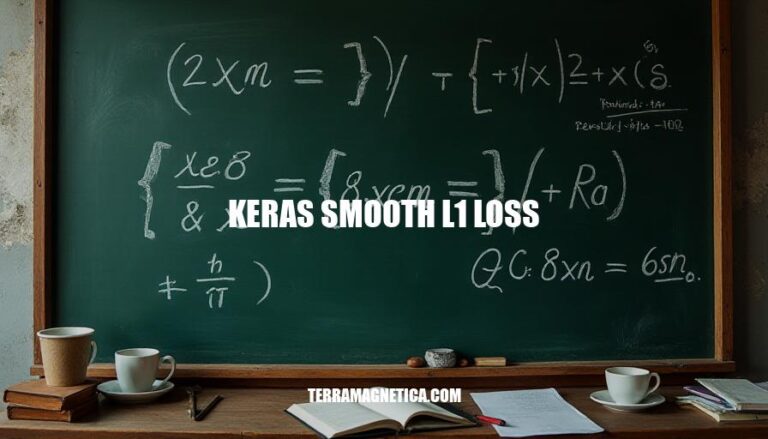


The Keras Smooth L1 Loss is a loss function used in machine learning models to balance the benefits of L1 and L2 losses. It is particularly effective in scenarios where you want to reduce the impact of outliers while maintaining sensitivity to small errors. This loss function is less sensitive to outliers compared to Mean Squared Error (MSE) and helps prevent exploding gradients, making it useful for tasks like object detection.
Keras Smooth L1 Loss is a loss function that combines L1 and L2 loss. It is less sensitive to outliers than L2 loss and prevents exploding gradients. The loss is calculated as follows:
Key parameters:
To implement Smooth L1 Loss in a Keras model, you can use the tf.keras.losses.Huber function, which is equivalent to Smooth L1 Loss. Here’s how you can do it:
import tensorflow as tf
from tensorflow.keras.models import Sequential
from tensorflow.keras.layers import Dense
model = Sequential([
Dense(64, activation='relu', input_shape=(input_dim,)),
Dense(64, activation='relu'),
Dense(1)
])
model.compile(optimizer='adam', loss=tf.keras.losses.Huber(delta=1.0))
delta is the threshold at which the loss function transitions from quadratic to linear. You can adjust this value based on your specific needs.history = model.fit(x_train, y_train, epochs=50, batch_size=32, validation_data=(x_val, y_val))
This setup uses the Huber loss function, which behaves like Smooth L1 Loss. The delta parameter controls the point where the loss function changes from L2 to L1 behavior.
: Keras Huber Loss Documentation
Using Keras’ Smooth L1 Loss, also known as Huber Loss, offers several benefits over other loss functions, particularly in terms of model performance:
Robustness to Outliers: Unlike Mean Squared Error (MSE), which can be heavily influenced by outliers, Smooth L1 Loss is less sensitive to extreme values. This is because it combines the best properties of L1 and L2 losses, applying L2 loss for small errors and L1 loss for large errors.
Stability in Training: The combination of L1 and L2 losses helps in stabilizing the training process. It prevents the model from being overly penalized for large errors, which can lead to more stable and faster convergence.
Balanced Gradient: Smooth L1 Loss provides a more balanced gradient, which can be beneficial for gradient-based optimization algorithms. This balance helps in avoiding the pitfalls of vanishing or exploding gradients, common issues with other loss functions.
Improved Generalization: By mitigating the impact of outliers and providing a balanced gradient, models trained with Smooth L1 Loss often generalize better to unseen data. This can lead to improved performance on validation and test datasets.
These benefits make Smooth L1 Loss a versatile and effective choice for various machine learning tasks, particularly those involving regression and object detection.
Here are some specific scenarios where keras smooth l1 loss is particularly useful:
Object Detection: In tasks like bounding box regression, smooth l1 loss helps in handling outliers by combining the benefits of L1 and L2 losses, making it robust to small errors and less sensitive to large errors.
Robust Regression: When dealing with regression tasks where the data may contain outliers, smooth l1 loss can provide a balance between mean squared error (MSE) and mean absolute error (MAE), offering robustness against outliers.
Pose Estimation: For estimating human or object poses, smooth l1 loss can be used to predict keypoint coordinates, providing stability and robustness in the presence of noisy data.
3D Reconstruction: In 3D object reconstruction tasks, smooth l1 loss can be used to minimize the error between predicted and actual 3D coordinates, ensuring smooth and accurate reconstructions.
Image Super-Resolution: When enhancing the resolution of images, smooth l1 loss can help in maintaining the fine details while being robust to noise and artifacts.
These examples illustrate how keras smooth l1 loss can be applied across various machine learning tasks to improve performance and robustness.
Keras Smooth L1 Loss is a versatile and effective choice for various machine learning tasks, particularly those involving regression and object detection.
It offers several benefits over other loss functions, including robustness to outliers, stability in training, balanced gradient, and improved generalization. This makes it suitable for tasks such as object detection, robust regression, pose estimation, 3D reconstruction, and image super-resolution.
By combining the best properties of L1 and L2 losses, Smooth L1 Loss provides a more stable and faster convergence, leading to improved performance on validation and test datasets.
Its ability to handle outliers and provide a balanced gradient makes it an ideal choice for tasks where data may contain noisy or extreme values.